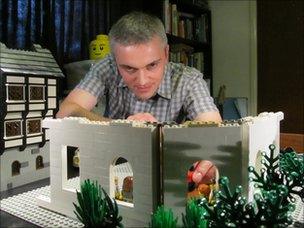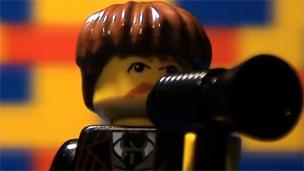Using Lego as the building blocks of movie making
- Published
WATCH: LJ Rich joins the singers who have become Lego pop video stars at the hands of animator Chris Salt
A brick does not move. Its very immobility is its defining characteristic.
The same is generally true of Lego. But not always - because there are times when those bricks spring into vibrant motion.
They do that when they are in the hands and before the camera lenses of the growing number of people making brick films. These are movies that use mini figures as actors and Lego bricks to build a set and dress it.
"Lego makes it a lot easier to throw things together," said veteran brick film maker Chris Salt. The sheer variety of bits and blocks means there are props for almost any film genre and all those parts are built to the same scale.
This solves one of the big obstacles that prevents people getting into stop motion animation - the huge effort required to create a set, characters and props before even a single frame of film is shot.

Many film makers like using Lego because all the bits are made to a consistent scale
Contemplating the scale of that pre-production task stopped Chris from trying it himself - despite being a big fan of animation.
But serendipity revealed how to overcome that obstacle.
"One day at work someone brought a digital camera in that had some stop motion software on it and they were playing around with desktop toys and things.
"That caught my imagination and I just happened to have a box of old Lego from my parents' house lying around," he said.
This was back in 2001 when there was no YouTube but there were some web-based communities centred around stop-motion film making.
"I picked up the basics from them and just played around," said Chris. His first brick films were of Lego mini figures performing a Mexican wave or doing a little dance.
He has moved on to produce music videos for bands, has worked with broadcaster Adam Buxton on a couple of movies and produced many original works of his own.
While the films have got much longer, more sophisticated and professional looking since the early days, Chris still uses the same camera - a Logitech webcam.
"It's cheap and it's designed to feed straight to a computer so you do not need to fiddle around with cables or anything like that," he said. His only extravagance nowadays has been video editing software to help with post-production work.
Film focus

Harry Bossert's brick film about a man with a megaphone helped get him to Hollywood.
Brick film maker Harry Bossert has also stuck with the kit that he used to produce his first movies.
Harry started with Lego films when he was 12. His moment of serendipity came when he was browsing YouTube and came across some early brick films.
"I was just struck by them," he said. "I thought it was really cool and watched some more and decided I wanted to do this."
With the help of his dad and the family camcorder he set up a small shooting stage on a table and got going.
"It ran at five frames per second and was very jerky and you could see most of my room in the background," he said. Despite the crudeness of that first effort the bug bit deep and he made one brick film a day for the next four days.
His initial audience was just friends, but their enthusiasm encouraged him to keep going and soon he started using YouTube to show off his creations.
Harry is also gaining wide recognition for his films. He produced one movie to illustrate the Megaphone song of former Nerf Herder frontman Parry Gripp. The track is about a security guard at the Santa Barbara International Film Festival using his megaphone to aggressively control a queue of frustrated movie goers.
He sent a tweet to Mr Gripp telling him about the video. The star liked it a lot and the end result was that Harry travelled to the US where his film about the Santa Barbara International Film Festival was shown at the Santa Barbara International Film Festival.

Making brick movies need not be expensive. Chris Salt uses an old Logitech webcam
"I thought that the most I would get was him commenting on the video," he said.
Like Chris Salt, Harry likes the fact that Lego figures and bricks are all made to the same scale. But, as with all brick film makers, the hard part is finding the time it takes to make a film when it takes 15 frames just to create one second of movie time.
"At my age I have got school and things and it's not really something you can fit in after school," he said. "I'm the one man production team. I write the scripts, do the story board, shoot the movie and edit it."
That sums up the joy and frustration of brick film making for both Harry Bossert and Chris Salt. It is all about you and what you make of it.
Said Chris: "It can take as much or as little time as you want. All you need is a base plate, a figure and a camera to point at it."
- Published26 January 2011
- Published10 April 2011
- Published20 April 2011